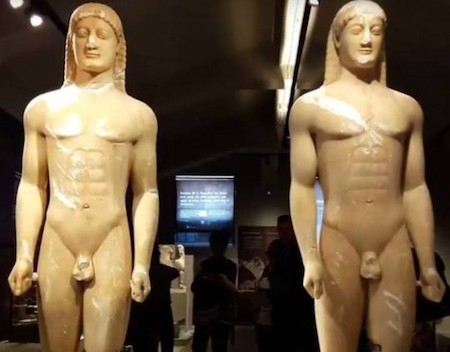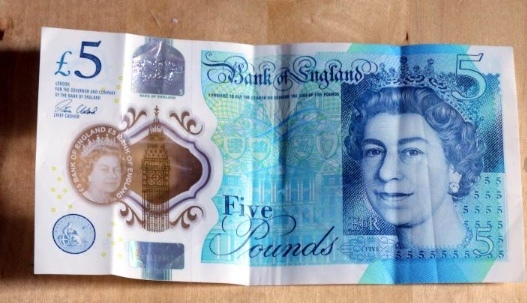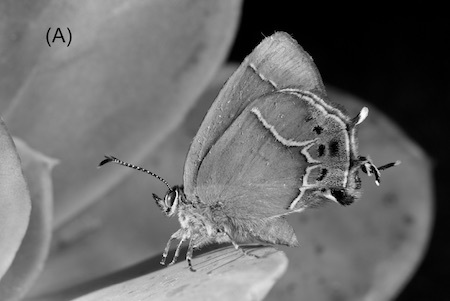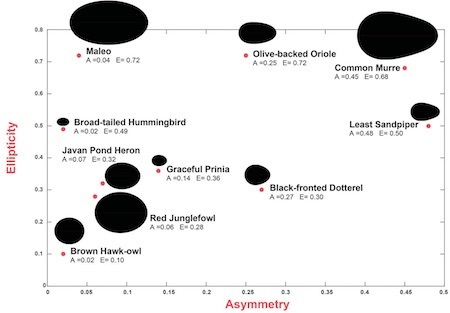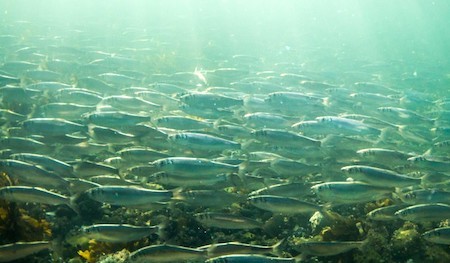Marc Abrahams's Blog, page 216
June 28, 2017
“Scrotal Asymmetry in Man and in Ancient Sculpture” research celebrated in Greece
“Scrotal Asymmetry in Man and in Ancient Sculpture” — the study that earned the 2002 Ig Nobel Medicine Prize — is given a keen appreciation, lavishly illustrated, in Athens magazine, in Greek. The study itself was published in the journal Nature, which featured it on the cover of their February 5, 1976 issue.
The study’s author, Chris McManus, is a professor of psychology and medical education, at University College London. McManus also is founding editor of the research journal Laterality.

A study in human emotion: Father Kramarz thrills to music
Thrill to the contrast between (1) the thrill of human emotion and (2) a highly-controlled absence of apparent emotion. In this video, Father Andreas Kramarz, LC, PhD. explains that music gives him emotional thrills:
The Bibliolore blog celebrates Father Kramarz’s thrilling achievement.
BONUS (distantly related): The fictional character Gus Fring exhibits emotional control, in this highlights video:

June 26, 2017
Mikko Kivelä joins the Luxuriant Flowing Hair Club for Scientists (LFHCfS)
Mikko Kivelä has joined the Luxuriant Flowing Hair Club for Scientists (LFHCfS). Ulrike Werner, who nominated him, says:
Mikko is a network scientist and Assistant Professor in complex systems. He has the most luxurious and flowing hair of any scientist I know. Maybe his hair is the visual representation of the networks he researches, especially when not brushed and full of knots (or nodes). Like his hair, he will also eventually untangle the science of complex networks.
Mikko Kivelä, Ph.D, LFHCfS
Assistant Professor
Aalto University
Department of Computer Science
Aalto, Finland


How money circulates [a new economics insight, using a bicycle in Britain]
John Stevenson, writing on the road.cc web site, explains how money circulates:
“Stuck in the middle of nowhere with a gert big gash in a lightweight tyre? The Bank of England Five Pound Note is an excellent, robust tyre boot that will get you home, and then you can pop out and spend it on well-deserved cake….”
“When the bank of England put its new fiver into circulation on 13 September last year, one of the proudly touted advantages of the new plastic note was that it was stronger and more durable than the previous paper version. The Bank said: ‘Each new polymer note is expected to last at least 2.5 times longer than the current paper notes. This is because polymer is stronger than paper so the notes can better withstand being repeatedly folded into wallets or scrunched up into pockets.’ … “

Exponential beer froth decay – disputed
Arnd Leike of the University of Munich was awarded the 2002 Ig Noble Physics prize for demonstrating that beer froth obeys the mathematical Law of Exponential Decay. [Reference “Demonstration of the Exponential Decay Law Using Beer Froth,” Arnd Leike, European Journal of Physics, vol. 23, January 2002, pp. 21-26.]
Since then, investigations into the decay of beer froth have continued – and one experimental research project in particular has challenged the idea that it decays exponentially. A team from the Institut für Angewandte und Physikalische Chemie–Arbeitsgruppe Chemische Synergetik, Universität Bremen, Germany, “call in question the results presented by Leike”, saying that :
“
It is our finding that the foam volume does not shrink simple exponentially but in terms of higher order according to the equation lnV(t) = a−bt −ct2.5 (3.1). The term ct2.5 describes the reorganisation of the bubble arrangements which will lead to an Apollonian gasket of bubbles. [our emphasis]”
in Discrete Dynamics in Nature and Society, Volume 2006, pp. 1–35, by S. SAUERBREI, E. C. Haß, AND P. J. PLATH.

June 23, 2017
Acoustical Watermelon Studies: Reaching for More Than What’s on Tap
To know whether a watermelons is ripe — before cutting into the melon — is a dream brought to exciting levels by generations of scientists, building on the wisdom and wishfulness of their ancestors. Here are three of the juicier studies published in recent times.
Acoustical Watermelon Study (1998)
“Study on acoustic characteristics of the watermelon,” M.S. Kim, D. S. Choi, Y. H. Lee, and Y. K. Cho, Journal of the Korean Society for Agriculture, 1998.
Acoustical Watermelon Study (2002)
“Numerical analysis on acoustic impulse response for watermelon,” Yong Sul Kim, Dong Hoon Yang, Young Jae Choi, Tas Joo Bae, Chul Ho So, and Yun Ho Lee, Proceedings of the Korean Society for Nondestructive Testing Spring Meeting 2002. The authors report: “As we analyzed impact pulse signal and extracted featured parameters concerned with evaluation of its ripeness, we found the plausibility of progress on nondestructive evaluation of ripeness and adoption of numerical analysis on acoustic impulse response.”
Acoustical Watermelon Study (2015)
“Nondestructive determination of watermelon flesh firmness by frequency response,” Rouzbeh Abbaszadeh, Ali Rajabipour, Yibin Ying, Mojtaba Delshad, Mohammad J. Mahjoob, and Hojjat Ahmadi, LWT-Food Science and Technology, vol. 60, no. 1, 2015, pp. 637-640. The authors, at Tehran University, report:
“The identification of watermelon ripeness from its appearance such as size or skin colour is very difficult. The common subjective method is usually based on the sound produced by a slap. This method is prone to human factor errors; it may be a good way only for people with much experience. This idea led researchers to study acoustic methods…. The main objective of the present work is to study the potential of laser Doppler vibrometery and vibration spectra for evaluation of watermelon firmness….
“Briefly, laser beam from the LDV device is directed to the upper surface of the sample and the vibrations are measured from the Doppler shift of the reflected beam frequency due to the motion of the surface. Amplitude and phase shift between the mentioned signals were extracted for the entire frequency range using fast Fourier transform applied to the response and the excitation signals…. [This nondestructive determination of watermelon flesh firmness by frequency response proved to be] accurate and fast.”

June 22, 2017
Two Heads (One of Them Real) Are Somewhat Better Than One
A new test of the old idea that apparently having a head at your rear might save your life, if you are a butterfly:
“Two-headed butterfly vs. mantis: do false antennae matter?” Tania G. López-Palafox and Carlos R. Cordero, PeerJ, vol. 5, 2017, e3493. The authors, at Universidad Nacional Autónoma de México, report:
“The colour patterns and morphological peculiarities of the hindwings of several butterfly species result in the appearance of a head at the rear end of the insect’s body…. We explored the role of hindwing tails (presumably mimicking antennae) in predator deception in the ‘‘false head’’ butterfly Callophrys xami. We exposed butterflies with intact wings and with hindwing tails experimentally ablated to female mantises (Stagmomantis limbata)…. [Our study indicates] that at least some aspects of the ‘false head’’ help C. xami survive some mantis attacks, supporting the notion that they are adaptations against predators.”

Why Are Bird Eggs Bird-Egg-Shaped? [New research from an Ig Nobellian]
Mahadevan, who won an Ig Nobel Physics Prize in 2007 for studying how/why wrinkled sheets become wrinkled, has a new study out about how/why bird eggs become bird-egg shaped. The study, by Mahadevan and several collaborators, is:
“Avian Egg Shape: Form, Function, and Evolution,” Mary Caswell Stoddard, Ee Hou Yong, Derya Akkaynak, Catherine Sheard, Joseph A. Tobias, and L. Mahadevan, Science, vol. 356, no. 6344, June 23, 2017, pp. 1249-1254. Here’s a bit of detail from it:
Ed Yong, writing in The Atlantic, savors the new paper:
Think about an egg and you’ll probably conjure up an ellipse that’s slightly fatter at one end—the classic chicken egg. But chickens are outliers. Hummingbirds lay eggs that look like Tic Tacs, owls lay nigh-perfect spheres, and sandpipers lay almost conical eggs that end in a rounded point. After analyzing hundreds of species, Stoddard showed that the most common shape—exemplified by an unremarkable songbird called the graceful prinia—is more pointed than a chicken’s.
“We mapped egg shapes like astronomers map stars,” Stoddard says. “And our concept of an egg is on the periphery of egg shapes.”
Beyond displacing chickens as the Platonic ideal of egg-dom, Stoddard’s data also helped her to solve a mystery that scientists have debated for centuries: Why exactly are eggs shaped the way they are?…
To solve it, Stoddard teamed up with L. Mahadevan, a biophysicist at Harvard University who has studied “how leaves ripple, how tendrils coil, and how the brain folds, among other things.” He realized that all eggs could be described according to two simple characteristics—how asymmetric they are, and how elliptical they are. Measure these traits, and you can plot every bird egg on a simple graph. They did that for the eggs of 1,400 bird species, whose measurements Stoddard extracted from almost 50,000 photos…
The Los Angeles Times report about this includes an appraisal by Charles Deeming, who himself was awarded a 2002 Ig Nobel Biology Prize for co-authoring the study “Courtship Behaviour of Ostriches Towards Humans Under Farming Conditions in Britain.” The LA Times writes:
Charles Deeming, an ecologist who studies bird reproduction at the University of Lincoln in England and who was not involved in the study, said that pelvis shape, in particular, could be critical in determining egg shape. With further research, he said, scientists may be able to narrow down a more specific link between bird anatomy and egg shape.

The place of fish farting in fish flirting and in international relations
The two independent research studies about herring farts gave different insights: one that fish probably use farting to communicate, the other that farting herrings in Stockholm harbor were mistakenly identified as Soviet submarines. Brian Owens appreciates these studies — their two sets of scientists shared the 2004 Ig Nobel Biology Prize — in an article in Hakai Magazine.
Owens’ article carries the headline “Quiet Please, the Fish Are Flirting — Fish that fart together stay together.”

Dirty Hands Make Dirty Leaders? (study)
 Florien Cramwinckel Msc (Utrecht University, The Netherlands) researches how people respond to the moral behavior of others. As part of this remit, an experiment was devised in which 78 participants demonstrated how dirtiness versus cleanliness might influence moral behavior in leader–subordinate relationships :-
Florien Cramwinckel Msc (Utrecht University, The Netherlands) researches how people respond to the moral behavior of others. As part of this remit, an experiment was devised in which 78 participants demonstrated how dirtiness versus cleanliness might influence moral behavior in leader–subordinate relationships :-
“They were asked touch, smell, and evaluate a dirty (fake poop) or clean (hygienic cleansing wipe) product and answer several questions about this product. These questions were how ‘‘handy,’’ ‘‘pretty,’’ ‘‘functional,’’ ‘‘nice,’’ ‘‘clean,’’ ‘‘dirty,’’ ‘‘useless,’’ ‘‘weird,’’ ‘‘funny,’’ and ‘‘realistic’’ they thought this product was (1 = not at all, 7 = completely). They also answered to what extent they would like to have this product, if they thought this product smelled nice, if they thought this product felt clean, if they would buy this product in a store and if they felt dirty after touching this product (1 = not at all, 7 = completely).”
Subsequent evaluation of the experimental results showed, amongst other things that :-
“ […] subtle cues such as bodily sensations can shape moral decision-making and behavior in leader–subordinate relationships, but selfinterest, as a core characteristic of interdependence, can override the influence of such cues on the leader’s moral behavior.”
See: Dirty Hands Make Dirty Leaders?! The Effects of Touching Dirty Objects on Rewarding Unethical Subordinates as a Function of a Leader’s Self-Interest. Journal of Business Ethics, Volume 115, Issue 1, pp 93-100,

Marc Abrahams's Blog
- Marc Abrahams's profile
- 14 followers


